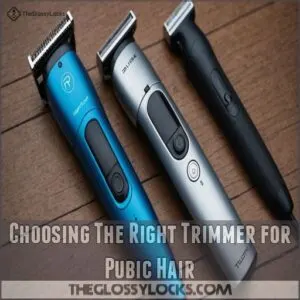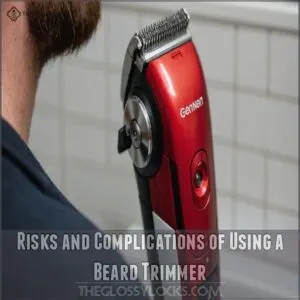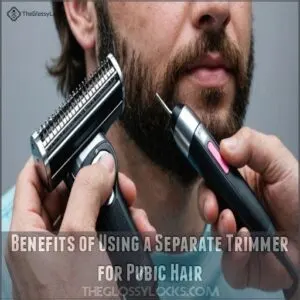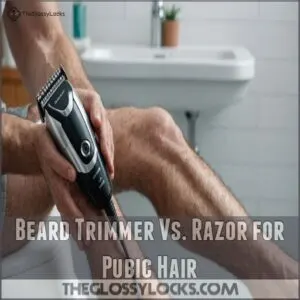This site is supported by our readers. We may earn a commission, at no cost to you, if you purchase through links.
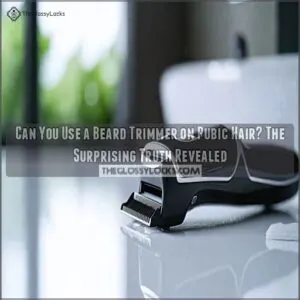 Yes, you can use a beard trimmer on pubic hair, but it’s not as simple as taking your face buzzer down south.
Yes, you can use a beard trimmer on pubic hair, but it’s not as simple as taking your face buzzer down south.
While it’s tempting to use one tool for all your hairy situations, there are some key things to keep in mind.
Your pubic area is more sensitive than your face, so you’ll need to be extra careful.
Think of it like mowing a delicate flower bed instead of a rugged lawn.
You’ll want to use a clean, well-oiled trimmer with adjustable guards to avoid any painful nicks or cuts.
And let’s be honest, nobody wants a pubic haircut gone wrong.
There’s more to this grooming adventure than meets the eye…
Table Of Contents
- Key Takeaways
- Using a Beard Trimmer for Pubic Hair
- Differences Between Beard and Pubic Hair
- Choosing The Right Trimmer for Pubic Hair
- How to Trim Pubic Hair With a Beard Trimmer
- Risks and Complications of Using a Beard Trimmer
- Benefits of Using a Separate Trimmer for Pubic Hair
- Beard Trimmer Vs. Razor for Pubic Hair
- Common Mistakes to Avoid When Using a Beard Trimmer
- Alternatives to Using a Beard Trimmer for Pubic Hair
- Frequently Asked Questions (FAQs)
- Can a beard trimmer shave pubes?
- Can a beard trimmer be used in the pubic area?
- Can you use a beard trimmer to shave?
- Should you use a pubic hair Trimmer?
- Should you use a beard trimmer or a groomer for men?
- How to use a beard trimmer?
- Can I use a beard trimmer to trim pubes?
- Can you use the same trimmer for face and pubic area?
- Can a beard trimmer be used for body hair?
- Can Philips beard trimmer be used for pubic hair?
- How often should I trim my pubic hair?
- Can women use beard trimmers for pubic hair?
- What length setting is best for pubic trimming?
- Is it necessary to use shaving cream or gel?
- How do I prevent ingrown hairs after trimming?
- Conclusion
Key Takeaways
- You can use a beard trimmer for pubic hair, but it’s not ideal due to the area’s sensitivity. It’s better to use a trimmer specifically designed for the job.
- Choose trimmers with features like sharp blades, waterproof designs, and ergonomic grips for better safety and performance.
- Keep separate trimmers for face and pubic areas to avoid cross-contamination and improve hygiene.
- Always follow proper trimming techniques with gentle strokes and good lighting to minimize the risk of cuts and irritation.
Using a Beard Trimmer for Pubic Hair
You might be eyeing that beard trimmer for a quick fix down there, but hold your horses!
While it’s tempting to use one tool for all your grooming needs, there’s more to think about regarding trimming your nether regions than you might think.
Pros and Cons of Using a Beard Trimmer
One might think using a beard trimmer on your nether regions is a stroke of genius, but hold your horses!
While it’s cost-effective and versatile for manscaping, your trimmer’s lifespan might take a hit.
Sure, you’ll save some dough, but your skin mightn’t be thrilled.
Blade longevity? Not great.
Skin sensitivity? Through the roof!
It’s like using a lawnmower on a putting green – risky business, folks!
Key Features to Look for in a Beard Trimmer
Ready to tackle the jungle down under?
When choosing a beard trimmer for your manscaping adventures, you’ll want to keep an eye out for these game-changers:
- Blade sharpness: Razor-sharp blades for a smooth, tug-free trim
- Cordless option with long battery life: Freedom to groom without getting tangled
- Adjustable guards and waterproof design: Versatility for different hair lengths and shower-friendly use
Trust me, your nether regions will thank you for picking a trimmer with these features!
Safety Precautions for Using a Beard Trimmer
Now that you’ve got your trimmer, let’s talk safety. Your family jewels deserve TLC, so follow these tips to avoid turning your grooming session into a comedy of errors. Remember, slow and steady wins the race in terms of manscaping.
| Do’s | Don’ts | Pro Tips |
|---|---|---|
| Use gentle strokes | Rush the process | Trim in good lighting |
| Keep skin taut | Apply too much pressure | Use a handheld mirror |
| Start with longer guards | Ignore skin irritation | Moisturize afterwards |
| Clean the trimmer after | Share your trimmer | Trim in the shower |
| Take breaks if needed | Trim on broken skin | Test on a small area first |
Hygiene and Maintenance of The Beard Trimmer
Let’s talk trimmer TLC, folks! You’ve navigated the safety zone, but keeping your beard trimmer clean is like flossing – nobody wants to, but it’s a game-changer.
After each trim, give those blades a good scrub with soap and water.
Then, hit ’em with some rubbing alcohol to zap any lingering germs.
Store your trimmer in a dry spot, and for the love of all things hygienic, don’t share it!
Differences Between Beard and Pubic Hair
You might think hair is just hair, but your beard and pubes are more different than you’d expect.
From texture to growth patterns and skin sensitivity, understanding these differences is key to choosing the right grooming tools and avoiding any awkward "oops" moments in your personal care routine.
Texture and Growth Patterns of Pubic Hair
Your beard and pubic hair are like distant cousins – related, but oh so different!
Pubic hair’s typically softer and more unruly, growing in all sorts of directions.
It’s also denser and can be curlier than your facial fuzz.
This wild growth pattern makes trimming tricky.
Your beard trimmer might struggle with these rebellious strands, so you’ll need to approach your below-the-belt grooming with care and patience.
Sensitive Skin in The Pubic Area
Ever wondered why your downstairs feels like a minefield?
Unlike your face, the skin in your pubic area is super delicate.
It’s like comparing a tough old boot to a silk glove.
To find the perfect tool for the job, look for a trimmer with features like stainless steel or titanium blades, which are gentle on sensitive skin.
This sensitive skin is prone
Implications for Using a Beard Trimmer
Now that we’ve covered the sensitive nature of your downstairs region, let’s talk about using a beard trimmer there.
It’s like trying to mow a delicate garden with a lawnmower – not ideal!
Beard trimmers aren’t designed for the curvy landscape of your nether regions, which can lead to nicks, irritation, and a less-than-stellar trim.
Plus, using the same tool on your face and privates? That’s a hygiene no-no that might make your skin scream!
Choosing The Right Trimmer for Pubic Hair
Finding the right trimmer for your nether regions can feel like wading through a sea of options.
You’ll want to weigh factors like blade sharpness, motor power, and safety features to make sure you’re not left with a hairy situation down there.
Electric Shaver Vs. Beard Trimmer Vs. Manual Shaver
Choosing the right tool for your nether regions is like picking the perfect dance partner – it’s all about the right moves and avoiding stepping on toes!
Let’s break down your options:
- Electric shavers: Close shave champs, but can be a bit harsh on sensitive skin
- Beard trimmers: Versatile and beginner-friendly, but mightn’t get as close
- Manual shavers: Precision kings, but require more skill and patience
Each has its pros and cons, so pick the one that suits your style and comfort level.
Remember, it’s not just about the tool, but how you use it!
Features of a Good Pubic Hair Trimmer
You’ve compared your options, but what makes a pubic hair trimmer truly great?
Let’s break it down.
The best trimmers for your nether regions have features that’ll make you wonder how you ever managed without them.
It’s important to remember, just like when choosing a shaver specifically for pubic hair, a good trimmer should offer safety and comfort.
Here’s a quick rundown of what to look for:
| Feature | Why It Matters | Example |
|---|---|---|
| Blade sharpness | Smooth, painless trim | Stainless steel blades |
| Waterproof design | Shower-friendly grooming | IPX7 rating |
| Ergonomic grip | Easy maneuvering | Non-slip rubber handle |
Remember, the right trimmer can make all the difference between a grooming disaster and a hair-raising success!
Alternatives to Using a Beard Trimmer
Let’s explore some alternatives to using a beard trimmer for your manscaping needs.
Waxing for men offers longer-lasting results, while sugaring for pubic hair is a gentler option.
Depilatory creams can be convenient but watch out for skin irritation.
For a high-tech approach, laser hair removal provides permanent reduction.
When shaving designs into pubic hair, consider using a dry trimming technique to minimize irritation and ingrown hairs, as recommended in techniques for shaving designs. Body trimmers designed specifically for pubic hair offer better control and safety.
Remember, preventing ingrown hairs is key, so exfoliate regularly no matter which method you choose.
How to Trim Pubic Hair With a Beard Trimmer
Ready to tackle the jungle down under with your beard trimmer?
Let’s walk through the process of trimming your pubic hair safely and effectively, from prep to aftercare, so you can rock that groomed look without any oops moments.
Preparation for Trimming Pubic Hair
Prep work is key to a smooth manscaping session.
Start by hopping in the shower to soften your pubic hair.
If you’re in the market for a new tool, check out the options for beard trimmers for pubic hair at online stores like beard trimmer products.
Trim longer hairs with scissors first – trust me, it
Trimming Techniques for The Pubic Area
Regarding trimming your pubic hair with a beard trimmer, it’s all about technique.
Start with clean, dry hair and use a guard to avoid nicks.
Here’s your game plan:
- Trim in the direction of hair growth
- Go slow and steady, especially around sensitive areas
- Use shorter guard lengths for a closer trim
- Stretch the skin gently for a more even result
Remember, practice makes perfect in the manscaping game!
Aftercare for Trimming Pubic Hair
Post-trim TLC is important for your freshly-groomed nether regions.
You’ll want to soothe irritation and prevent those pesky ingrown hairs.
Here’s a quick guide to keep things smooth sailing down there:
| Action | Purpose |
|---|---|
| Apply aloe vera | Soothe irritation |
| Moisturize | Prevent dryness |
| Wear loose clothing | Minimize friction |
Remember, no scratching!
Let your skin breathe and heal.
Trust me, your bits will thank you for the extra care.
Risks and Complications of Using a Beard Trimmer
You might think using a beard trimmer on your pubic hair is no big deal, but hold onto your shorts because there’s more to it than meets the eye.
From skin irritation and sneaky infections to the dreaded nicks and cuts in your most sensitive areas, we’re about to uncover the risks that’ll make you think twice before going full lumberjack down there.
Skin Irritation and Infections
You’ve mastered the trim, but hold on to your shorts. Using a beard trimmer down there can be like inviting trouble to a party in your pants.
Here’s why you might end up with more than you bargained for: improper shaving techniques can lead to skin irritation and breakouts, similar to how shaving causes acne.
- Bacteria transfer: Your trimmer might become a bacterial taxi
Nicks and Cuts in The Pubic Area
Let’s talk about the not-so-fun part of trimming down there.
Nicks and cuts in your pubic area are like uninvited guests at a party – nobody wants them!
Your delicate bits are extra sensitive, so using a beard trimmer can be like dancing with scissors.
To prevent pubic area cuts, go slow and steady, use a guard, and keep the skin taut.
If you do get a cut, clean it gently and give it some TLC to heal.
Long-term Consequences of Using a Beard Trimmer
Let’s talk about the long game when using a beard trimmer down under.
Over time, you might notice your skin getting more sensitive.
Blade dulling is real, and it can lead to tugging and irritation.
Your trimmer’s lifespan might take a hit too.
Hygiene issues can crop up if you’re not careful, and those pesky ingrown hairs? They could become your new unwanted friends.
It’s like playing grooming roulette – sometimes you win, sometimes you lose.
Benefits of Using a Separate Trimmer for Pubic Hair
You’ll be amazed at how much better your grooming experience can be when you use a separate trimmer for your pubic hair.
You’ll keep things cleaner down there, but you’ll also extend the life of your tools and reduce the risk of nicks and irritation.
Better Hygiene and Reduced Risk of Infection
Using a separate trimmer for your pubic hair isn’t just about avoiding nicks and cuts.
It’s a game-changer for your personal hygiene.
By keeping your beard and pubic trimmers apart, you’re creating a barrier against cross-contamination risks.
Think about it – do you really want face bacteria mingling with your nether regions?
Here’s why a dedicated pubic trimmer is worth it:
- No more "ick factor" when trimming your beard
- Reduced risk of embarrassing infections down there
- Peace of mind knowing you’re grooming smartly
Remember, proper cleaning methods for each trimmer are key to maintaining excellent hygiene practices and preventing infections.
Your body will thank you for this simple yet effective grooming hack!
Improved Performance and Longer Trimmer Life
Your beard trimmer’s got a tough job, but it’ll last longer if you give it a break from pubic duty.
Keeping separate trimmers for your face and downstairs mix-up isn’t just about hygiene – it’s about performance too.
Your facial hair‘s different from your nether regions, so why not treat ’em right?
Regular cleaning and oiling will keep both trimmers sharp and happy, ready for action when you need ’em.
Reduced Risk of Injury and Discomfort
Down under in sensitive territory, a dedicated pubic hair trimmer is your best friend.
It’s like having the right tool for the job – you wouldn’t use a sledgehammer to hang a picture, right?
With gentler blades and specialized guards, you’ll avoid the ouch factor.
Say goodbye to nicks, cuts, and that dreaded razor burn.
Proper trimming techniques become a breeze, and your skin will thank you for the extra TLC.
Beard Trimmer Vs. Razor for Pubic Hair
You’re standing in front of your bathroom mirror, debating whether to reach for your trusty beard trimmer or that razor you’ve been eyeing.
Let’s compare these two pubic hair grooming champs and help you pick the perfect tool for your downstairs landscaping needs.
Comparison of Shaving Methods
Let’s talk about the hairy situation of choosing between a beard trimmer and a razor for your downstairs grooming.
Beard trimmers often come with guard combs for precise trimming. Beard trimmers offer versatility with adjustable guards, perfect for maintaining some length.
If you’re looking for a dedicated tool for pubic hair trimming, you can find some great options by checking out a guide to best pubic hair trimmers.
Razors, on the other hand, give you that close shave if you’re going for the smooth look.
Your skin sensitivity might be the deciding factor here.
Remember, whatever you choose, take it slow to avoid any ouch moments!
Advantages and Disadvantages of Each Method
Weighing the pros and cons of beard trimmers versus razors for pubic hair can feel like choosing between a rock and a hard place. But don’t worry, we’ll break it down for you.
Here’s the lowdown on both methods:
- Beard trimmers: Less skin irritation, but might leave stubble
- Razors: Smoother finish, but higher risk of nicks and ingrown hairs
- Cost and maintenance: Trimmers are pricier upfront but
Choosing The Best Option for Your Needs
Your grooming goals are the compass for choosing between a beard trimmer and a razor.
Consider your skin sensitivity, hair type, and desired look.
Beard trimmers offer versatility and less irritation, while razors give a closer shave.
Here’s a quick comparison:
| Feature | Beard Trimmer | Razor |
|---|---|---|
| Closeness | Trimmed look | Smooth shave |
| Skin irritation | Less likely | More common |
| Versatility | Multiple lengths | One length |
Remember, there’s no one-size-fits-all solution.
Experiment to find what works best for your unique needs and comfort level.
Common Mistakes to Avoid When Using a Beard Trimmer
You’ve got your beard trimmer in hand, ready to tackle your pubic hair, but hold up—there are some pitfalls you’ll want to dodge.
From using the wrong guard to neglecting proper hygiene, these common slip-ups can turn your grooming session into a hair-raising experience.
Using The Wrong Guard or Attachment
Now that you’ve chosen your weapon, let’s talk about a common blunder: using the wrong guard or attachment.
To help you avoid this, it’s important to understand the importance of choosing the right blade length, just as you’d when choosing the right trimmer for different body parts,
It’s like trying to mow your lawn with scissors – you’ll end up with a patchy mess!
Different guard lengths and attachment types can make or break your trim.
Too short? Hello, skin irritation.
Too long? Say hi to an uneven trim.
Choose wisely, and your pubic hair will thank you!
Not Following Proper Trimming Techniques
The trimming tango can be tricky, especially down there.
Don’t go against the grain or you’ll be in for a world of hurt.
Trim in the direction of hair growth to avoid ingrown hairs and razor burn.
Take it slow, champ – rushing leads to nicks and uneven patches.
Use gentle, steady strokes and let the trimmer do the work.
Remember, you’re sculpting a masterpiece, not mowing the lawn!
Not Maintaining Good Hygiene and Safety
Let’s talk hygiene and safety, folks! While mastering trimming techniques is great, keeping things clean is where it’s at. Here’s your ‘down there’ care checklist:
- Clean your trimmer before and after use
- Never share your pubic hair trimmer (ew, just don’t)
- Store it in a dry place to prevent bacterial growth
- Replace blades regularly for the best performance
Remember, a clean trimmer means happy skin and no nasty infections. It’s like brushing your teeth – a daily must!
Alternatives to Using a Beard Trimmer for Pubic Hair
If you’re not sold on using a beard trimmer down there, don’t worry – you’ve got options.
From smooth waxing to quick creams, we’ll explore some hair-free alternatives that might just make your sensitive bits a whole lot happier.
Waxing and Sugaring for Hair Removal
Smooth operators, listen up! Waxing and sugaring are like the dynamic duo of hair removal, leaving your sensitive bits silky for weeks. But heads up, they’re not for the faint-hearted. You can find a variety of sugaring pastes designed for sensitive areas, like this sugaring paste, to help make the experience a little less ouch.
Check out this comparison to see if you’re ready to say goodbye to your beard trimmer:
| Method | Pain Level | Smoothness | Duration |
|---|---|---|---|
| Waxing | Ouch! | Baby-smooth | 3-4 weeks |
| Sugaring | Less ouch | Super soft | 3-4 weeks |
| Trimming | Painless | Stubbly | Days |
Remember, these methods need some TLC between sessions. Exfoliate gently and moisturize to keep your skin happy.
Depilatory Creams and Other Hair Removal Methods
Tired of tugging and trimming?
Depilatory creams might be your new best friend for pubic hair removal.
These creams dissolve hair at the surface, leaving you smooth without the hassle.
But heads up, they’re not for everyone.
Some folks find them irritating, especially down there.
Always do a patch test first and follow instructions carefully.
For a gentler approach, try epilators or laser hair removal – they’re gaining popularity for their long-lasting results.
Traditional Razors and Other Options
While creams mightn’t be your cup of tea, don’t forget the old-school razor.
It’s like the Swiss Army knife of pubic hair removal – versatile and reliable.
Just remember, shaving cream is your best friend to avoid razor burn.
For a smoother ride, try disposable razors or pubic trimmers.
They’re gentler on your skin and help dodge those pesky ingrown hairs.
Whatever you choose, take it slow and steady to keep your bits happy!
Frequently Asked Questions (FAQs)
Can a beard trimmer shave pubes?
Did you know 60% of men groom down there?
You can use a beard trimmer on pubes, but it’s like using a chainsaw for origami.
It’ll work, but you’re better off with a dedicated tool for your sensitive bits.
Can a beard trimmer be used in the pubic area?
You can use a beard trimmer on pubic hair, but it’s not ideal.
Sensitive skin calls for gentler tools.
If you’re in a pinch, go slow and use guards.
Better yet, invest in a trimmer made for down there.
Can you use a beard trimmer to shave?
Beard trimmers can give you a close shave, but they’re not designed for a smooth finish.
They’ll leave some stubble behind.
For a baby-bottom smooth look, stick with a traditional razor or electric shaver.
Should you use a pubic hair Trimmer?
Pubic hair trimmers are designed for the job, offering safety and precision.
They’re gentle on sensitive skin and reduce the risk of nicks.
Plus, you’ll avoid that awkward moment when your beard trimmer starts smelling like… well, you know.
Should you use a beard trimmer or a groomer for men?
Picture your grooming tools as knights in shining armor.
For your face, the beard trimmer reigns supreme.
But for the delicate area below, a specialized groomer‘s your go-to hero.
It’s all about matching the right tool to the task.
How to use a beard trimmer?
Ready to tame that facial forest?
Start with clean, dry hair.
Choose your desired length guard, power up, and glide against the grain.
Take it slow, especially around edges.
Remember, practice makes perfect – you’ll be a pro in no time!
Can I use a beard trimmer to trim pubes?
Coincidentally, many wonder about this!
You can use a beard trimmer on pubes, but it’s not ideal.
The sensitive skin down there needs extra care.
For safety and hygiene, it’s better to use a dedicated pubic hair trimmer.
Can you use the same trimmer for face and pubic area?
While you can use the same trimmer, it’s not recommended.
You’re better off keeping separate tools for face and pubes.
Cross-contamination‘s a real risk, and your sensitive bits deserve their own gear.
Play it safe, keep ’em separate!
Can a beard trimmer be used for body hair?
Think of your beard trimmer, like the versatile Philips OneBlade Face + Body Trimmer Shaver used for pubic hair, as a versatile Swiss Army knife for body hair.
You can use it on your chest, legs, and armpits.
It’s not ideal for sensitive areas, though.
For those spots, you’ll want a specialized tool.
Can Philips beard trimmer be used for pubic hair?
You can use a Philips beard trimmer for pubic hair, but it’s not ideal.
It’s like using a lawnmower on a putting green – it’ll work, but you mightn’t get the smooth result you’re after.
Consider a dedicated body groomer instead.
How often should I trim my pubic hair?
Trimming frequency depends on your personal preference and hair growth rate.
Generally, every 2-4 weeks keeps things tidy.
Listen to your body – if it’s itchy or uncomfortable, it’s time for a trim.
Just don’t go overboard, tiger!
Can women use beard trimmers for pubic hair?
Ladies, tame your garden with a beard trimmer? Absolutely!
It’s not just for the guys.
While designed for facial fuzz, these versatile tools can tackle your delicate areas too.
Just be gentle and use the right attachments for a smooth experience.
What length setting is best for pubic trimming?
The best length setting for pubic trimming depends on your preference.
Start with a longer guard, around 1/4 inch (6mm), and work your way down.
It’s like mowing a lawn – you can always take more off, but you can’t put it back!
Is it necessary to use shaving cream or gel?
Ninety percent of guys skip the cream!
You don’t need shaving cream or gel with a trimmer; it’s mostly for razors.
But, a little lube might help for a smoother, less irritated experience.
How do I prevent ingrown hairs after trimming?
To dodge those pesky ingrown hairs after trimming, gently exfoliate your skin before and after.
Exfoliate before and after trimming to prevent ingrown hairs.
Trim in the direction of hair growth.
Use sharp blades to prevent ingrown hairs.
Moisturize well after trimming.
It’s a good recipe for smooth, bump-free skin!
Conclusion
Surprisingly, around 63% of people try using regular beard trimmers for their pubic hair.
While you can use a beard trimmer on pubic hair, it’s not as straightforward as it appears.
Take into account the pros and cons, and prioritize safety and hygiene.
Picking the right trimmer—designed for sensitive areas—can prevent discomfort.
You’ve got options like electric shavers or razors, so find what works best for you.
Stay careful and comfortable in your grooming routine!
- https://my.clevelandclinic.org/health/diseases/17722-ingrown-hair
- https://www.mayoclinic.org/diseases-conditions/acne/symptoms-causes/syc-20368047
- https://www.aad.org/public/everyday-care/skin-care-basics/hair/how-to-shave
- https://www.huffpost.com/entry/beard-pubic-hair_n_56e0610ee4b0860f99d7745f?ylavq0k9=
- https://thebeardclub.com/blogs/beard-culture/can-you-use-beard-trimmer-on-pubic-hair

